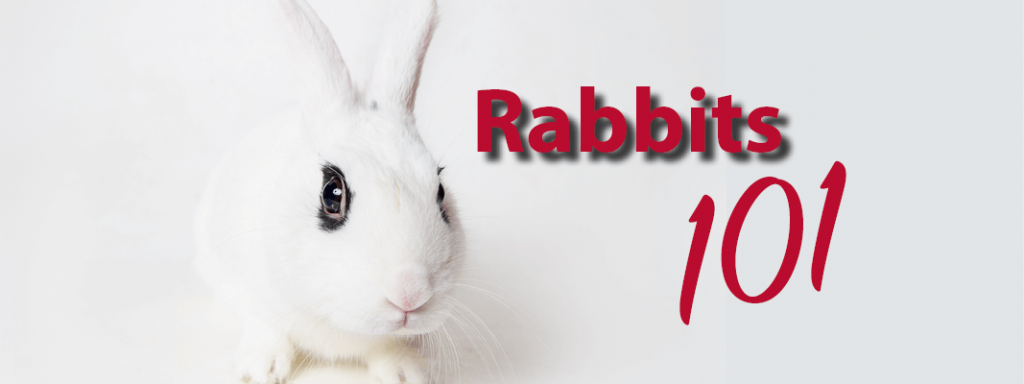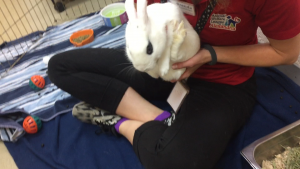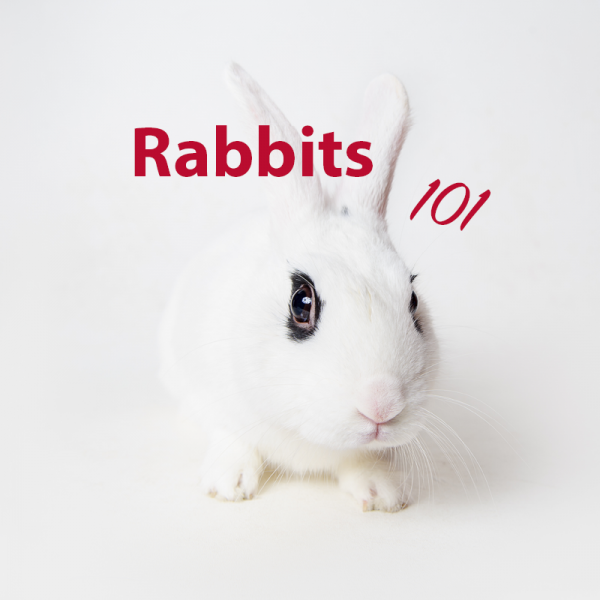 As an open-access shelter, the AWLA sees a lot of different animals besides dogs and cats, and we want to make sure every pet owner has the information they need to care for their new furry, feather or scaled friend.
As an open-access shelter, the AWLA sees a lot of different animals besides dogs and cats, and we want to make sure every pet owner has the information they need to care for their new furry, feather or scaled friend.
If you’ve always wanted a pet with a little more “bounce” in their step, then a bunny might be just your speed. Learn more about how to make a rabbit part of your family with assistance from Oreo the bunny and our Adoptions team:
Housing
With rabbit enclosures, the bigger the better. Some rabbit owners even elect to have their bunnies free roam, and litter box training is possible with many rabbits. Your rabbit’s enclosure should have a rug, towel or blanket covering the floor. If your bunny enjoys chewing in his free time, you can find chewable mats made of sisal or grass that are commonly used as outdoor mats and sold in stores or online. Keep an eye on your rabbit to make sure he is not chewing on a rug, towel or anything else that could result in him ingesting indigestible strings or create holes that his nails or legs could get stuck in.
Rabbits need their food and water bowls in their enclosures as well as a litter box and hay rack. Most rabbits prefer their hay to be near or around their litter box hung in a rack for convenient chewing and pulling. It’s okay if your bunny hangs out in his litter box; that’s just what bunnies do!
Hey, Hay!

Rabbits should have access to hay (along with fresh water) all day long. They snack frequently because hay is essential to their digestive system. Adult rabbits should have Timothy hay because it is high in fiber and helps them grind down their teeth. Baby and pregnant rabbits require different types of hay for proper nutrition.
Diet
Rabbits mostly eat hay and drink water, but they might also enjoy pellet food and treats. If your rabbit seems to be gaining weight, it is best to restrict these and just stick to hay and water. You can buy all kinds of food and treats and your local pet store, but be sure to watch out for animal by-products and fatty foods like nuts and seeds, as they can negatively affect your bunny’s intestinal health.
Rabbits also enjoy fresh veggies as treats, but watch for foods high in calcium, like kale and other dark leafy greens. Bunnies may enjoy broccoli, Brussels sprouts, cauliflower (especially the green leaves) and arugula, among others. Just keep in mind that your rabbit may have never eaten cauliflower or other vegetables before, so introduce new foods in moderation.
Daily Activities

Rabbits spend their days napping, eating hay, playing with toys and eating more hay. Especially if you only have one rabbit, they will likely seek out love and attention, and might even become a lap bunny. Bunnies get bored too, but rabbit toys exist to keep them entertained, including balls they can push around, cardboard boxes for hiding and chewing and other interactive items.
Make sure to give your rabbit plenty of exercise. You can let him hop around the house or use a rabbit harnesses or outdoor enclosure that will allow you and your rabbit to explore the outdoors safely. Never leave your rabbit unattended outside, since domesticated rabbits might not know how to hide from predators and are also quick diggers who can craft an escape tunnel in minutes.
Anything Else?
Rabbits, especially those with long hair, need to be brushed regularly, and although they do not need vaccines, they should visit the vet once a year for an annual check-up to make sure it’s healthy hopping.
If you have any other questions about life with rabbits, contact our Adoptions team at adoptions@alexandriaanimals.org or
703-746-4774.
Please note that Oreo has been adopted, but we appreciate his help in making our Rabbits 101 video.


